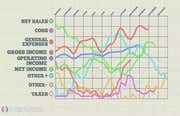|

|
Before we can begin to consider what fixed-asset turnover is, it’s helpful to review what fixed assets are in the first place. A fixed asset is any tangible piece of property, used over the long term, which a company owns and uses in its general operations. They are also known as capital assets and property, plant, and equipment (PP&E). (For more information on financial performance ratios more broadly, look to our tutorial on that subject.)
Although fixed assets represent only one type of assets a company owns, in many cases they are the largest share of the total asset pool. Fixed-asset turnover, then, is a ratio which aims to measure how productive a company’s fixed assets are when it comes to generating sales. The higher that the yearly turnover rate on these assets is, the better the company is at managing them and using them to generate sales.
Formula
The formula for fixed-asset turnover is as follows:
Fixed-asset turnover ratio = Revenue/PP&E
For a hypothetical company with annual revenue of $1 million and average fixed assets, or PP&E, of $200,000, the fixed-asset turnover ratio would be as follows:
$1,000,000/$200,000 = 5
To calculate a company’s fixed-asset turnover ratio, it’s useful to look to a company’s income statement for revenue figures and to a balance sheet for PP&E details.
Variations
There are ways to vary the fixed-asset turnover ratio to reflect other types of efficiency. For instance, some asset-turnover ratios make their calculations based on total assets. While it could be argued that this provides a fuller picture of a company’s activity, some analysts prefer fixed-asset turnover ratios because they represent a sizable component of the balance sheet, and thus a range of management decisions over different capital expenditures. The idea, then, is that capital investment and its results is, in fact, a better indicator of performance than what is evidenced in overall asset turnover.
It’s important to keep in mind that fixed-asset turnover ratios are relative. There is no specific number or threshold above which a company is doing a successful job at generating revenue from its fixed asset investments. Thus, a single calculation of fixed-asset turnover ratio is not particularly useful; rather, comparing this ratio for a single company over time or between similar companies is far more helpful.
Before placing too much trust in this particular ratio, it’s also important to keep in mind that different companies in varying industries have vastly disparate investments in fixed assets. For example, tech companies often have low fixed-asset bases relative to heavy manufacturing companies. Thus, a fixed-asset turnover ratio for a leading tech company is a less useful means of gauging performance than a similar ratio would be for a heavy manufacturing company.
Higher fixed-asset turnover ratios are often the result of comparably low investments in PP&E, rather than an indication of high sales. Companies which are not capital intensive, they are better able to generate high levels of sales on relatively low capital investment. However, some industries, such as natural resource companies, tend not to experience this.
Operating Performance Ratios: Sales/Revenue Per Employee
-
 Investing
InvestingHow to Evaluate a Company's Balance Sheet
Asset performance shows how what a company owes and owns affects its investment quality. -
 Investing
InvestingFund Transactional Activity
Portfolio turnover is one of the simplest measures of mutual fund quality quality. Find out how to measure it. -
 Investing
InvestingRatio Analysis
Ratio analysis is the use of quantitative analysis of financial information in a company’s financial statements. The analysis is done by comparing line items in a company’s financial ... -
 Investing
InvestingLiquidity Measurement Ratios
Learn about the current ratio, quick ratio, cash ratio and cash conversion cycle. -
 Investing
InvestingKey Financial Ratios for Retail Companies
Using the following liquidity, profitability and debt ratios, an investor can gather deeper knowledge of a retail company's short-term and long-term outlook. -
 Investing
InvestingMutual Fund Due Diligence: 5 Things to Look Out for in Quarterly Reports
Learn about five important items found in a mutual fund's annual and quarterly reports and why investors should pay attention to changes in these items. -
 Investing
InvestingFord's 4 Key Financial Ratios (F)
Learn about Ford Motor Company and how to analyze its business using financial ratios that help assess leverage, operations and profitability. -
 Trading
TradingTarget Vs. Walmart: Who's Winning The Big Box War?
Wal-Mart (WMT) outdoes Target (TGT) in number of stores, total assets, and market cap. But which company is more profitable? -
 Investing
InvestingMutual Funds That Reduce Your Taxes
It may be best to opt for ETFs over mutual funds, which allow wiser investors to reduce their tax obligations.


